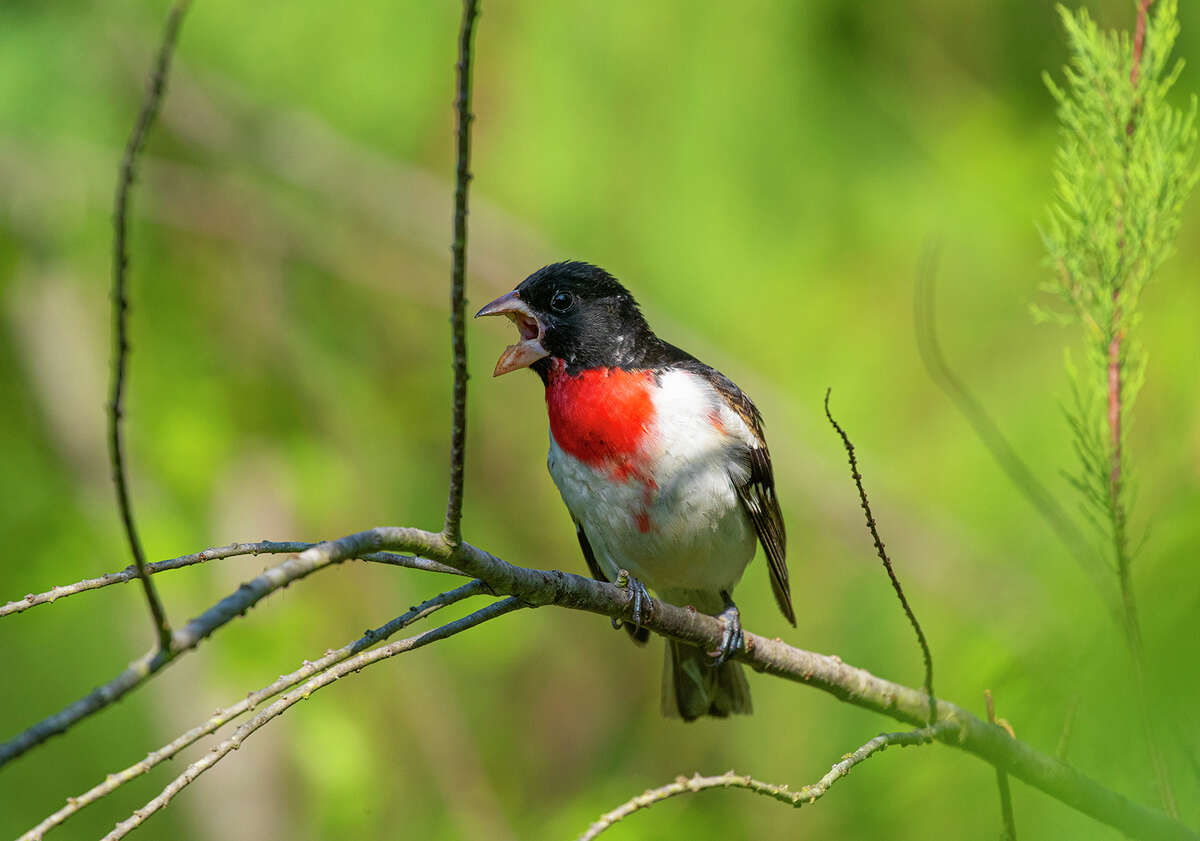Rose-breasted grosbeaks arrive in Houston straight from the tropics
Gary Clark
April 11, 2023
 1of4A rose-breasted grosbeak calls out to its mate. Look for the birds during migration in backyards and woodlots. Photo Credit: Kathy Adams Clark. Restricted use.Kathy Adams Clark/Kathy Adams Clark/KAC Productions 1of4A rose-breasted grosbeak calls out to its mate. Look for the birds during migration in backyards and woodlots. Photo Credit: Kathy Adams Clark. Restricted use.Kathy Adams Clark/Kathy Adams Clark/KAC Productions 
Come April, readers often tell me about the excitement of seeing a gloriously plumaged rose-breasted grosbeak in their yards.
People are excited because the bird looks like it plopped down in Houston straight from the tropics, which is exactly what it did. The bird flew here from tropical lands in southern Mexico, Central America and South America.
A male rose-breasted grosbeak seizes attention with its gleaming, red triangle-shaped bib over a plush white breast. The bird looks like an oddly plumed cardinal, bulked up on steroids. It has a similar but stouter conical-shaped beak that’s pinkish white. Turns out that grosbeaks and cardinals are in the same family.
The female is so drab that it’s often overlooked, despite sticking near the male in many instances. Her plumed brown back, brown streaked underside, and brown-and-white head stripes allow her to move unnoticed in a tree. Yet she has the same bulky size as the maled, with a broad chest and robust beak.
The gaudy male is now showoff, though. He can be as elusive as the female because his black back enables him to slip unnoticed within the shadows of tree foliage.
Rose-breasted grosbeaks
Male rose-breasted grosbeaks migrate to northern breeding grounds before females.
When breeding pairs are formed, they remain monogamous.
A breeding pair cooperates in building a roughhewn cup-shaped nest out of twigs, grasses, decayed leaves, and other materials.
Nests are sturdy but not dense, allowing views of the eggs by looking up through the bottom.
The birds are kin to black-headed grosbeaks that breed in mountainous areas of West Texas.
Females of both species look similar, but male black-headed grosbeaks differ with cinnamon bodies.
The birds must sneak through leafy trees to avoid being spotted by hawks that would love to pick off a grosbeak for a meaty meal.
We have a good chance to see the birds in our yards because they’ll be migrating through our area in waves until early May. They’ll stop at wooded lots, coastal bird sanctuaries and neighborhood backyards to replenish themselves with a diet of fruits, berries, beetles and seeds from weeds and birdfeeders.
They move slowly through trees and around birdfeeders, and they are quite tolerant of people, at a reasonable distance. Their relatively passive behavior allows us lingering views and a chance to take photographs. But let’s be respectful toward the birds and not harass them.
Males may utter their mating song, which resembles a robin’s song but with clear, fluted tones rather than the robin’s hoarse melody.
The birds will migrate to breeding grounds in the central and eastern U.S. and into Canada. They’ll come back here in autumn on the way to Latin American wintering grounds, but will not linger as they do in spring.
https://www.houstonchronicle.com/lifestyle/home-garden/article/rose-breasted-grosbeaks-17886195.php?sid=59a6f76b24c17c0f2e5c8edd&ss=A&utm_source=newsletter&utm_medium=email&utm_term=news_a&utm_campaign=HC_MorningReport |





 1of4A rose-breasted grosbeak calls out to its mate. Look for the birds during migration in backyards and woodlots. Photo Credit: Kathy Adams Clark. Restricted use.
1of4A rose-breasted grosbeak calls out to its mate. Look for the birds during migration in backyards and woodlots. Photo Credit: Kathy Adams Clark. Restricted use.
